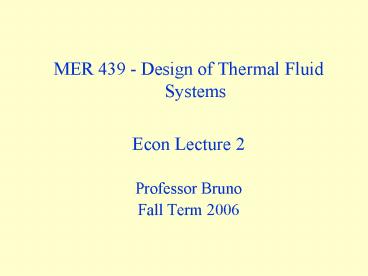MER 439 Design of Thermal Fluid Systems - PowerPoint PPT Presentation
1 / 13
Title:
MER 439 Design of Thermal Fluid Systems
Description:
The Uniform. amount of increase. each period is the. gradient amount. The amount in the ... A woman deposited $700 per year for 8 years. ... – PowerPoint PPT presentation
Number of Views:30
Avg rating:3.0/5.0
Title: MER 439 Design of Thermal Fluid Systems
1
- MER 439 - Design of Thermal Fluid Systems
- Econ Lecture 2
- Professor Bruno
- Fall Term 2006
2
Gradient Factors
- Engineering Economic problems frequently involve
disbursements or receipts that increase or
decrease each year (i.e. equipment maintenance) - If the increase is the same every year this is
called a uniform arithmetic gradient.
The Uniform amount of increase each period is
the gradient amount
The amount in the initial year is called a
base amount, and it doesnt need to equal the
gradient amount
Present Value _at_ time zero
3
Gradient Factors
To get the Gradient Factors we subtract off the
base amount, and start things in year (period) 2
PG Present worth of the gradient starting in
year 2 This is what is calculated by P/G factor.
PT (total) PGPA
PA comes from using the P/A factor on an annuity
equal to the base amount.
- P/G factor to convert a gradient series to a
present worth. - A/G factor to convert a gradient series to an
equivalent uniform annual series.
4
PG/G and AG/G
5
Gradients
- Example
- Find the PW of an income series with a cash flow
in Year 1 of 1200 which increases by 300 per
year through year 11. Use i 15
6
Review of Factors
- Using the tables..
- Single Payment factors (P/F), (F/P)
- Uniform Series factors (P/A), (F/A)
- Gradients (A/G), (P/G)
7
Unknown Interest Rates and Years
- -Use tables
- Unknown Interest rate
- i.e. F 20K, P 10K, n 9 ? i ?
- Or A 1770, n 10, P 10K ? i ?
- Unknown Years sometimes want to determine the
number of years it will take for an investment to
pay off ( n is unknown) - A 100, P 2000, i 2 ? n ?
8
Unknown interest example
- If you would like to retire with 1million 30
years from now, and you plan to save 6000 per
year every year until then, what interest rate
must your savings earn in order to get you that
million?
9
Use of Multiple Factors
- Many cash flow situations do not fit the single
factor equations. - It is often necessary to combine equations
- Example? What is P for a series of 100
payments starting 4 years from now?
years
1 2 3 4 5 6 7 8 9 10 11 12 13
100
P ?
10
Use of Multiple Factors
- Several Methods
- 1. Use P/F of each payment
- 2. F/P of each and then multiply by P/F
- 3. Get F A (F/A, i,10), then P F (F/P,i,13)
- 4. Get P3 A(P/A,I,10) and P0 P3(P/F,i,3)
years
1 2 3 4 5 6 7 8 9 10 11 12 13
100
P ?
11
Use of Multiple Factors
- Step for solving problems like this
- 1. Draw Cash Flow Diagram.
- 2. Locate P or F on the diagram.
- 3. Determine n by renumbering if necessary.
- 4. use factors to convert all cash flows to
equivalent values at P or F.
12
Use of Multiple Factors
- Example
- A woman deposited 700 per year for 8 years.
Starting in the ninth year she increased her
deposits to 1200 per year for 5 more years. How
much money did she have in her account
immediately after she made her last deposit?
13
Eng Econ Practice Problems
- Check Website for Practice ProblemsRemember you
ALL have a quiz on Engineering Econ Next Friday,
not just the economists. - You can see me (as Prof. Bruno) for free help on
engineering econ!































